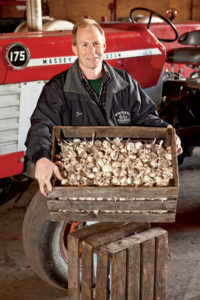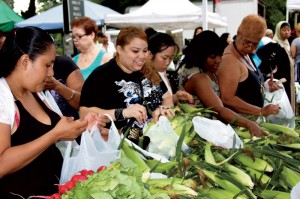Black Dirt, Big Bounty
The Morgiewicz family grows great produce in one of North America’s most fertile regions—just an hour from one of the world’s largest cities.
By Des Keller | Photos By Des Keller and Greg M. Cooper

The Morgiewicz brothers, Dave, Joe and Dan, replant in their farm’s rich, coal-black soil just weeks after hurricane Irene washed out some 70% of their income for the year.
Despite intermittent rain this August morning, throngs of customers press against tables covered with onions, radishes, carrots and eggplants of various hues. We’re in the heart of the Bronx, in New York City, and the office buildings, apartments and traffic are squeezed together as tightly as the throngs jostling for sweet corn. Still, the produce displayed offers a real sense of nature’s bounty.
This is the Morgiewicz Produce stand in the shaded green oasis that is Claremont Park. From May to November, once a week the daylong Harvest Home Mt. Eden Farmers’ Market puts fresh, local produce in the hands of residents whose access to such fare is limited, at best.
There is virtually no English being spoken among the myriad customers, but Dan Morgiewicz, who is running the stand, knows well what they want. “We have to parcel out the sweet corn so we have a supply throughout the day,” says the burly farmer, rivulets of sweat running down his temple. When a new container of corn is dumped onto the table, Dan and his cohorts have to referee how many ears a given customer can pull aside and sift through in search of the choicest ears.
But it’s not just the sweet corn. Every year, Dan, his brothers Joe and David, and other family members, grow up to 40 different types of produce—from artichokes to scallions to eggplants. The sheer variety, quality and bulk of their labors make them marquee attractions. This farmers’ market is just one of 11 around the city at which they sell in a typical year. Wholesalers also buy their produce for sale to restaurants and other markets, in The Big Apple.
The Morgiewicz family coaxes all of their crops from 150 acres in what is known as The Black Dirt Region. The area, which is located about an hour outside the city, covers approximately 26,000 acres of Orange County, N.Y., and Sussex County, N.J., and is the remnant of what was once the bottom of an ancient glacial lake. Outside of the Florida Everglades, this is one of the largest concentrations of so-called “muck” soils in the United States.
“Over the course of time—thousands of years—constantly decaying vegetation left these peat-like soils,” says Joe. “In some areas here, the soil is more than 100 feet deep and consists of 100% organic matter.” Compare that to some of this country’s prime crop areas that have soils with just 3% to 5% organic matter.
Despite being so close to New York City, the region’s frequent flooding by the Wallkill River and dark, poorly drained soils deterred the area’s development for anything but farming. Still, it wasn’t until a drainage canal was built in 1835 and an influx of Polish and German farmers familiar with such soils arrived that vegetable production became firmly established.

The fourth generation to work their family’s farm, the Morgiewicz brothers sell their 40 different types of produce to wholesalers and in 11 farmers’ markets throughout the New York metro area.
The Morgiewicz family arrived from Poland in 1895 and worked for other farmers before starting their own operation on 4 to 5 acres in 1905. The region became famous for producing onions, and even the Morgiewicz family grew almost nothing but the aromatic marvels for nearly 30 years—from 1969 to 1997. While they still grow plenty of onions, they began to branch out in 1995, growing radishes and cilantro for wholesale. In 1997, they began growing additional crops for the burgeoning farmers’ market business in the city. They haven’t looked back.
The Morgiewicz brothers run the farm with another eight family members involved either full or part-time. In all, Morgiewicz Produce employs about 40 people. They are adept at spacing out their plantings so there is plenty available at markets in June, as well as in August and September. In fact, they will likely still be picking carrots, beets and even dill well into October.
The nearly year-round process is labor intensive. Some delicate products, such as tomatoes, are only handled when they are picked, are not washed, and then are loaded by hand into crates bound for the various farmers’ markets. Vegetables like radishes might go through a three- or four-step process that involves bunching, washing them in a mechanical washer, then re-packing for market or wholesale.
As farmers, the Morgiewicz brothers have always chuckled about people they refer to as “commuters,” those who had to travel into the city to make a living. “We thought those people were nuts,” laughs Joe. “Now I do it 4 days out of 7—basically I’m commuting,” he says of his runs between the markets and farm.
The rise of farmers’ markets has become a huge driver in the Morgiewicz business. Their presence at inner-city markets like Claremont Park are made economically possible by the Farmers’ Market Nutrition Program (FMNP). The FMNP provides payments through the Women, Infants, and Children program and the Commodity Supplemental Food Programs to help low-income women and seniors purchase fresh fruits and vegetables.
At Claremont Park, nearly every customer is using FMNP checks to purchase produce. Morgiewicz Produce is then reimbursed for their sales when the coupons are redeemed. This subsidy has been cut back in the past year, and more cuts may be coming.
“This could be detrimental to us, but it depends on how much they cut the program,” says Joe. “At a market like Mt. Eden, more cuts would hurt a lot. In peak season, 50% to 70% of what we sell is purchased with food stamps or FMNP checks.”
There are other hazards that are even more difficult to foresee. Only 2 days after we first visited their operation last year, the remnants of Hurricane Irene—a rare, meteorological event in this part of the country—dumped 8 to 12 inches of rain on most of the Morgiewicz farm, resulting in the loss of about 70% of their anticipated income for 2011.
Daunted but not dissuaded, the family immediately began replanting some crops on 50 to 60 less-saturated acres loaned by a neighbor. They also purchased vegetables from other area growers. As a result of such efforts, the family was back in business and harvesting spinach, lettuces and beets well into fall. “We looked at ourselves and said, ‘This is a blow that has set us back a great deal,’” Joe recalls a few months after the storm. “But we frantically planted some items after Hurricane Irene, planted some things earlier than normal this spring and added different crops we normally wouldn’t have planted.”
Cost cutting also became the order of the day. That’s why there is now a wood stove being used to heat the greenhouse, instead of propane fuel. Morgiewicz Produce has adapted to changing conditions before, and they are again.
So even if there’s a nip in the fall air, don’t worry that the Morgiewicz family doesn’t have much to sell you—chances are they have plenty. They’ve gotten pretty good at coaxing a lot of good eats out of that thick, black dirt.





